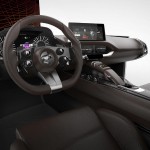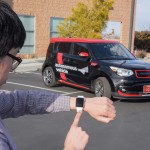KIA has laid its autnomous driving cards on the table at CES this year, with the focus being on bringing semi-autonomous features to their vehicles by 2020 and full autonomous vehicles by 2030. The Korean company has created a new sub-brand, “DRIVE WISE” for what it is calling Advanced Driver Assistance Systems (ADAS). The idea is, of course, to increase safety for all on our roads and to this effect KIA will commence public road testing in Nevada using their excellent Soul EV as a test mule for autonomous systems.
https://youtu.be/w6fX2fCK264
The autonomous driving technologies are broken down into several major categories including; Highway Autonomous Driving (HAD), Urban Autonomous Driving (UAD), Preceding Vehicle Following (PVF), Emergency Stop System (ESS), Traffic Jam Assist (TJA) and Autonomous Valet Parking. These technologies may make their appearance separately or together on KIA’s future vehicles, offering the customer a choice of technology that suits them best.
DRIVE WISE also includes interaction between driver and car including gesture control that seems to be a recurring theme at CES this year. KIA’s gesture control combines with a fingerprint reader to enable user specific functions, for example setting a drivers’ preferred mood in the cabin along with their favourite music selection. You can read the rest of the release below for further detail.
Kia Motors has introduced the launch of a new sub-brand, ‘DRIVE WISE’, to encompass its future Advanced Driver Assistance Systems (ADAS). DRIVE WISE embodies Kia’s philosophy to realise intelligently safe vehicles featuring Kia’s latest and forthcoming ADAS technologies. Kia recently announced plans to manufacture partially-autonomous cars by 2020, and aims to bring its first fully-autonomous vehicle to market by 2030.
Debuting at the 2016 Consumer Electronics Show (CES) in Las Vegas, 6-9 January, Kia’s innovative DRIVE WISE technologies are currently under development. Engineered to improve safety for all road users, DRIVE WISE will enable Kia to introduce intelligent safety technologies to its future model range, helping to eliminate potential dangers – and, for some, the tedium – of driving, while changing the ways in which owners interact with their vehicles.
Later in the year, Kia will showcase many of its innovative new DRIVE WISE technologies at the 2016 Geneva Motor Show, where visitors will be able to preview Kia’s future autonomous driving and assistive technologies.
Kia unveils DRIVE WISE technologies at CES 2016
Kia’s CES 2016 illustrates the progression of its autonomous driving technologies, from those available in current models to cutting-edge features being developed over the next 15 years under the DRIVE WISE banner. Kia’s exhibit at the increasingly popular show gives visitors the chance to experience a host of next-generation technologies and concepts with interactive displays.
Tae-Won Lim, Senior Vice President, Central Advanced Research and Engineering Institute of Hyundai Motor Group, commented, “Kia is undergoing a very promising and gradual process of introducing partially and fully autonomous technologies to its vehicles. Although the first marketable fully-autonomous car from Kia will not be available in the immediate future, the work our R&D teams are currently doing to develop our range of DRIVE WISE technologies is already improving on-road safety and driver assistance. The innovations presented at this year’s show demonstrate the future direction we are taking.”
DRIVE WISE technologies to improve on-road safety
By 2020, Kia aims to introduce its first partially-autonomous car with DRIVE WISE technologies, building upon the current generation of driver-assistance systems.
The more advanced technologies under development by Kia provide the driver with greater levels of assistance, anticipating and reacting to changing road conditions and potential hazards to improve safety for all road users. By helping to eliminate many of the inherent dangers, stresses and hassles of driving on today’s congested roads, DRIVE WISE will enable owners to focus more on the pleasures of driving.
Kia’s future DRIVE WISE technologies on display at CES 2016 include Highway Autonomous Driving, Urban Autonomous Driving, Preceding Vehicle Following, Emergency Stop System, Traffic Jam Assist and a new Autonomous Parking & Out function:
- Highway Autonomous Driving (HAD) employs a combination of radar and camera detection systems to interpret lane markings, allowing the car to stay in its lane or switch into others to overtake other vehicles or follow a different road; all without driver input.
- Urban Autonomous Driving (UAD) applies GPS and sensors to identify the car’s position on the road, allowing it to safely navigate through densely-congested city environments while responding to live traffic updates.
- Preceding Vehicle Following (PVF) is an enhanced lane-keeping system which monitors the vehicle in front and allows the car to calculate its own path relative to it, following at a safe distance if road markings are indecipherable due to poor conditions or road layout.
- Emergency Stop System (ESS) operates in correlation with Kia’s Driver Status Monitoring (DSM) system, to analyse the driver’s face, ensuring their attention does not stray from the road for too long. If it detects that the driver takes their eyes from the road for too long, ESS can automatically direct the car into an appropriate side lane and come to a halt.
- Traffic Jam Assist (TJA) monitors the vehicle in front during congested traffic conditions, maintaining a safe distance from the vehicle in front and moving into appropriate spaces to gain ground.
- Autonomous Valet Parking allows drivers to exit the car and let the vehicle park itself remotely, activated using the smart key or a smartwatch.
DRIVE WISE technologies are primarily designed to make driving safer and easier for Kia customers by identifying hazards at the earliest possible opportunity and allowing the driver – or the car – to take appropriate action, though drivers can circumvent them with direct control, enabling closer control of the car as desired.
Next-generation vehicle interaction
DRIVE WISE technologies will also facilitate communication and interaction between the driver and vehicle with innovative new Human Machine Interface (HMI) functions, such as gesture control, fingerprint sensors and smart-device connectivity.
Featured in a special I-Cockpit display at CES, Kia’s next-generation HMI is based on the concept of ‘blind control’, with a fingerprint touchpad and gesture recognition used to operate the car’s controls. Automatically recognising individual driver’s preferences on start-up – based on their fingerprint or smartwatch – the car can immediately change the cabin ambience for the driver with their favourite music, preferred climate control temperature and the type of information displayed by the instrument panel.
Drivers’ gestures are recognised by the I-Cockpit if they want to change any setting in the cabin, without taking their eyes off the road ahead.
License granted to test Kia DRIVE WISE on Nevada public roads
The preliminary investment by Kia – totalling US$2 billion by 2018 – will enable the company to fast-track development of its new DRIVE WISE technologies. The U.S. state of Nevada recently granted Kia a special licence to test the new technologies on public roads. Kia’s all-electric Soul EV – the company’s first globally-sold electric car – is acting as the brand’s testbed for the development of next-generation DRIVE WISE technologies, as it takes to the roads around Death Valley.
Fully-autonomous cars on the market within 15 years
Key to Kia’s future DRIVE WISE technologies is the development of its vehicle-to-everything (V2X) communications system. For Kia to advance its partially-autonomous ADAS technologies far enough to bring the true ‘self-driving car’ to market by 2030, V2X must be fully integrated into real-life driving environments and be able to react as a human driver can.
V2X applies a series of sensors, radar, LiDAR (Light Detection And Ranging Radar) and external cameras, to perceive the surrounding environment and all relevant obstacles, as a human driver does. The system incorporates vehicle-to-vehicle (V2V) and vehicle-to-infrastructure (V2I) technologies as well, allowing the car to recognise, judge and control every driving scenario, obstacle or potential threat.
Source; KIA


